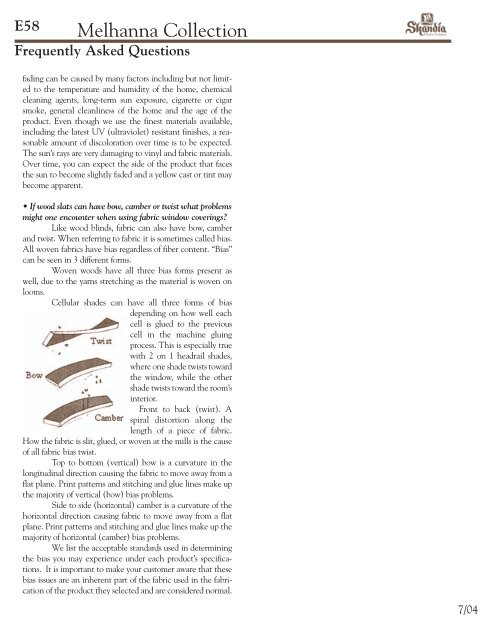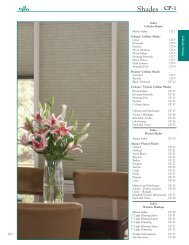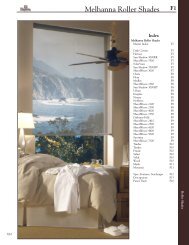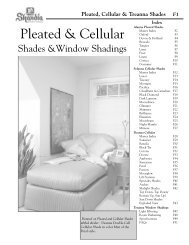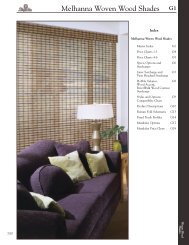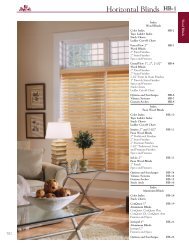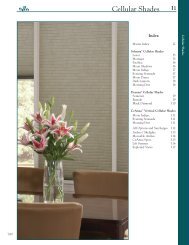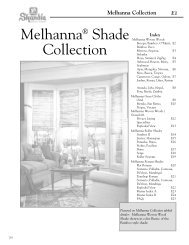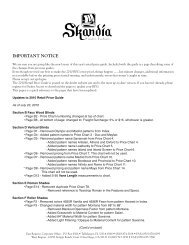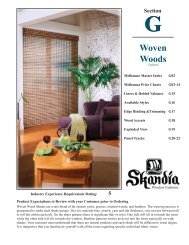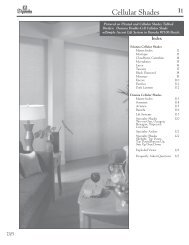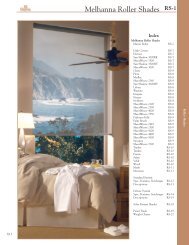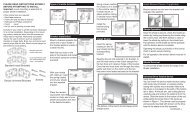Melhanna Collection - Skandia Window Fashions
Melhanna Collection - Skandia Window Fashions
Melhanna Collection - Skandia Window Fashions
Create successful ePaper yourself
Turn your PDF publications into a flip-book with our unique Google optimized e-Paper software.
E58<br />
<strong>Melhanna</strong> <strong>Collection</strong><br />
Frequently Asked Questions<br />
fading can be caused by many factors including but not limited<br />
to the temperature and humidity of the home, chemical<br />
cleaning agents, long-term sun exposure, cigarette or cigar<br />
smoke, general cleanliness of the home and the age of the<br />
product. Even though we use the finest materials available,<br />
including the latest UV (ultraviolet) resistant finishes, a reasonable<br />
amount of discoloration over time is to be expected.<br />
The sun’s rays are very damaging to vinyl and fabric materials.<br />
Over time, you can expect the side of the product that faces<br />
the sun to become slightly faded and a yellow cast or tint may<br />
become apparent.<br />
• If wood slats can have bow, camber or twist what problems<br />
might one encounter when using fabric window coverings?<br />
Like wood blinds, fabric can also have bow, camber<br />
and twist. When referring to fabric it is sometimes called bias.<br />
All woven fabrics have bias regardless of fiber content. “Bias”<br />
can be seen in 3 different forms.<br />
Woven woods have all three bias forms present as<br />
well, due to the yarns stretching as the material is woven on<br />
looms.<br />
Cellular shades can have all three forms of bias<br />
depending on how well each<br />
cell is glued to the previous<br />
cell in the machine gluing<br />
process. This is especially true<br />
with 2 on 1 headrail shades,<br />
where one shade twists toward<br />
the window, while the other<br />
shade twists toward the room’s<br />
interior.<br />
Front to back (twist). A<br />
spiral distortion along the<br />
length of a piece of fabric.<br />
How the fabric is slit, glued, or woven at the mills is the cause<br />
of all fabric bias twist.<br />
Top to bottom (vertical) bow is a curvature in the<br />
longitudinal direction causing the fabric to move away from a<br />
flat plane. Print patterns and stitching and glue lines make up<br />
the majority of vertical (bow) bias problems.<br />
Side to side (horizontal) camber is a curvature of the<br />
horizontal direction causing fabric to move away from a flat<br />
plane. Print patterns and stitching and glue lines make up the<br />
majority of horizontal (camber) bias problems.<br />
We list the acceptable standards used in determining<br />
the bias you may experience under each product’s specifications.<br />
It is important to make your customer aware that these<br />
bias issues are an inherent part of the fabric used in the fabrication<br />
of the product they selected and are considered normal.<br />
7/04


